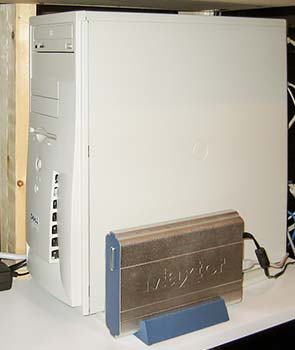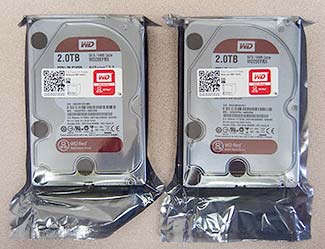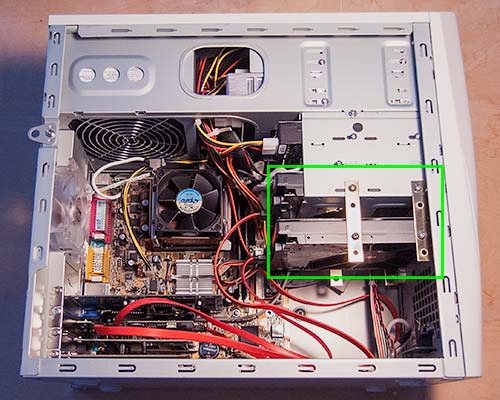www.lumen-perfectus.com
Being Served
“A picture is worth a thousand words but it takes 3,000 times the disk space.”
Jerry Smith
As explained in last month's article, I've spent more of this winter indoors than is usual for me. I've had plenty to keep me busy; one of those projects has been to replace the hard drives in the server computer on which I store my image files. This gets a little technical, but I'll try to minimize the geek-speak as I show-and-tell the upgrade.

The original Dell Dimension 4100-based server. This early version used an external USB drive for off-site storage.
I use Macintosh computers for my photo work; image processing and printing, backing up camera files when working in the field, inventory and asset management, accounting, contacts and correspondence, Web site development and maintenance, the works. After making a living from the late 1970s through the late 2000s with other platforms and operating systems, I find the Mac works best for me today.
I still have, however, several old Windows XP computers here. A couple are collecting dust, but one is critical to my photo work. This is my “file server”, an ancient Intel Pentium box providing shared storage on our network. I bought the PC in 2001, soon after Microsoft released Windows XP. The computer, along with Jasc Software's Paintshop Pro (now a Corel product) and a Hewlett-Packard film scanner, became my digital darkroom; the jpegs for my original Web site came from this setup. No doubt some of the picture files on today's site are from that combination of gear. Eventually I replaced Paintshop Pro with Photoshop CS (the original, numberless version), and added a Nikon V ED film scanner after selling the HP via eBay. I did little printing then, making most images only to post as jpegs on the Web. But the new software and the higher-resolution scanner produced significantly larger files, which I wanted to keep after the jpegs were made. Back then I didn't know where I might go with photography or, more accurately, were photography would take me, but it seemed a good idea to preserve the large scans from which I made my site's jpegs.
Anatomy of a server

The newest (two terabyte) pair of drives waiting to be installed in today's server.
In the first half of the 2000s hard drives were slow and expensive compared to what's available today, but they were what we had. I bought a used Dell Dimension 4100 with Windows XP, stuffed the case with hard drives, and shared those drives with my Photoshop computer via my wired (100-megabit/second) network. While setting up this scheme I decided to install a RAID 1, in which two drives connected to a RAID card would be mirrored, that is, each drive would be an exact copy of the other at all times. If a drive failed, I could replace it, and the array would be automatically rebuilt so the new drive's content matched the older working drive. RAIDs aren't magic backup systems, but instead provide redundancy to help protect against drive failure and other potential problems.
This system, shown at the top of the page, used a Promise Technology FastTrak TX4300 four-channel RAID card and two Western Digital (WD) WD4000YR SATA drives. The card and drives cost $550.00 and provided close to 400 gigabytes of storage. That seemed a whopping high capacity. I added a case fan to the computer help cool the drives. The resulting system, while large and loud, worked perfectly. Isolated and invisible in a wiring closet, the machine's noise never intruded into our living space.
Several months after assembling this system I added a removable drive bay to the computer. Along with that I purchased several removable “trays” for additional drives. I could then periodically back up the RAID to a drive in a tray, slide the tray from the machine, and store it off-site. In the event of catastrophic system failure or some type of disaster (fire, flood, vandalism, theft), I'd have a backup in another location. With hard drives in two of these removable trays, I've swapped my off-site backups at least once a month.

Inside the current server, a Windows XP box from 2001. The green box shows the new two-terrabyte drives. The red cables connect to the RAID card.
By the end of 2006 it became clear I needed greater capacity. Photo files consumed only half of the RAID's drive space. Although not originally my intended use for the RAID, other files, some photo-related, others not, filled the rest. I bought a pair of Western Digital WD5000YS drives (500 gigabyte). I installed those in the computer, and moved the former RAID drives into removable trays. I backed up only the photo files to the removable drives, so the smaller capacity drives were more than adequate for off-site storage.
In early 2008 I bought a Mac Pro, replacing the old Windows XP computer on which I'd done all my photo work up to that point. For details, see the “Computers and Operating Systems” section of my article “Versus”.
Today's Server

The current server with 2 terabyte RAID and removable drive tray, shown partially removed. Another drive tray is on the shelf above the UPS.
Since it was sitting around unused, it seemed sensible to repurpose the 2001 XP machine to replace the larger and slower Dell server. Some mechanical tinkering would be needed to accommodate adding the RAID drives; I saw no difficulty getting that done. I added a gigabit Ethernet card and an additional fan, moved the RAID, and put the old Dell out to pasture (eventually hauling it away for recycling). The removable drive bay was an easy fit into the newer machine. When finished, performance was better, and thanks to the faster network card, data transfer from the Mac was much faster.
A year later (October, 2009) I replaced the 500 gigabyte drives in the RAID with a pair of Samsung one terabyte drives. The smaller drives were moved to the removable trays. This arrangement served well until January, 2014, when I installed a pair of Western Digital “Red” two terabyte drives in the RAID, moving the one-terabyte drives to the removable trays.
The Next Generation
My server's new capacity should be adequate for the remaining useful life of the computer, which I'd guess to be another two years, give or take. There's no shortage of network storage options; replacing the server will be fairly easy. By the time I'm investigating this, I'll likely have replaced the Mac Pro as my main working machine. The Mac Pro would make an excellent server, although it's quite power hungry. It's probably not the best option. NAS (network attached storage) boxes have become common. These are purpose-built cases with a power supply, bays for a number of hard drives, network connectivity, and software (often Linux-based) to make it all work. They are easy to set up, relatively small and quiet, and not terribly expensive.
Hard drive trivia: Since I built up the first server, with its 400 gigabyte drives, the cost per gigabyte of storage has dropped dramatically. The first drives in the RAID, the 400 gigabyte WDs, cost $210 each. The 500 gigabyte WDs that replaced those were $175. The one-terabyte Samsungs used in the next swap cost $150 each. The current two-terabyte WDs cost $110. These are all server-grade “bare” drives.
February, 2014
All products and brand names mentioned are trademarks or registered trademarks of their respective owners.